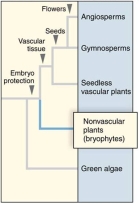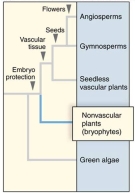A) ferns
B) club mosses
C) whisk ferns
D) gnetophytes
E) horsetails
G) B) and C)
Correct Answer

verified
D
Correct Answer
verified
Multiple Choice
Which of the following groups of plants contain microphylls?
A) Lycophytes
B) Pteridophytes
C) Bryophytes
D) Gymnosperms
E) Angiosperms
G) None of the above
Correct Answer

verified
Correct Answer
verified
Multiple Choice
What is the correct sequence of events during the life cycle of a moss? A.Gametes are produced in the archegonia and antheridia B.Spores are released C.The zygote develops within the archegonium D.The mature sporophyte develops from the gametophyte and produces spores E.Flagellated sperm swim towards the egg for fertilization F.Spore germinates into the protonema
A) a - e - c - d - b - f
B) a - e - f - d - b - c
C) a - b - d - c - b - f
D) f - e - b - d - a - c
F) A) and C)
Correct Answer

verified
Correct Answer
verified
Multiple Choice
Characteristics of eudicots include all EXCEPT
A) two cotyledons.
B) leaves with netted veins.
C) woody or herbaceous plants.
D) flower parts in fours and fives.
E) vascular bundles arranged irregularly in the stem.
G) B) and E)
Correct Answer

verified
Correct Answer
verified
Multiple Choice
The dominant plants in modern times are the _________ due to their relationship with animal pollinators.
A) gymnosperms
B) angiosperms
C) club mosses
D) ferns
F) B) and C)
Correct Answer

verified
Correct Answer
verified
Multiple Choice
Which of the following statements about lycophytes is correct?
A) The megaspores will develop into female gametophytes.
B) The microspores will develop into female gametophytes.
C) The megaspores will develop into male gametophytes.
D) Lycophytes were the first land plants to evolve megaphylls.
F) C) and D)
Correct Answer

verified
Correct Answer
verified
Multiple Choice
In the alternation of generations life cycle of plants,gametes are produced by the
A) sporangia.
B) fruit.
C) gametophyte.
D) homospores.
E) strobili.
G) All of the above
Correct Answer

verified
Correct Answer
verified
Multiple Choice
Identify the feature found in Cooksonia that qualify it as a vascular plant.
A) presence of roots
B) contained leaves
C) had branches that ended in sporangia
D) produced windblown spores
F) None of the above
Correct Answer

verified
Correct Answer
verified
Multiple Choice
Molecular data suggests that land plants evolved from
A) charophytes.
B) rhodophyta.
C) dinoflagellates.
D) the water molds.
E) ciliates.
G) None of the above
Correct Answer

verified
Correct Answer
verified
Multiple Choice
In the pine life cycle,
A) fertilization occurs shortly after pollination to produce the zygote.
B) the gametophyte generation is dominant and the sporophyte generation is inconspicuous.
C) seed cones are smaller than pollen cones.
D) seed cones are located near the tips of higher branches and pollen cones develop near the tips of lower branches.
E) the cone is the fruit that surrounds the seeds.
G) A) and B)
Correct Answer

verified
Correct Answer
verified
Multiple Choice
Which of the following features would not be found in the bryophytes?
A) A life cycle that consists of an alternation of generations.
B) Using megaphylls to increase their photosynthetic ability.
C) Production of flagellated sperm during reproduction.
D) A gametophyte that is dependent upon the sporophyte for support and nutrition.
F) None of the above
Correct Answer

verified
Correct Answer
verified
Multiple Choice
The fiddlehead is a _______ that unfolds into a ______.
A) diploid gametophyte; fern frond
B) diploid sporophyte; fern frond
C) haploid sporophyte; fern frond
D) haploid gametophyte; fern frond
E) diploid gametophyte; moss plant
G) B) and D)
Correct Answer

verified
B
Correct Answer
verified
Multiple Choice
Gymnosperm are characterized by producing "naked seeds".Which of the following group is not classified as a gymnosperm?
A) horsetails.
B) cycads.
C) conifers.
D) gnetophytes.
E) ginkgoes.
G) A) and B)
Correct Answer

verified
Correct Answer
verified
Multiple Choice
According to the cladogram pictured here,land plants and green algae 
A) are in different clades and form a polyphyletic group.
B) are in the same clade and form a monophyletic group.
C) do not share common ancestry.
D) None of the above.I would suggest picking a specific group to ask about instead of land plants.
F) None of the above
Correct Answer

verified
Correct Answer
verified
Multiple Choice
Evidence for plants evolution from a freshwater algal species is supported by which of the following?
A) Both green algae and plants have chlorophylls a and b and various accessory pigments.
B) Both green algae and plants store excess carbohydrates as starch and have cellulose in their cell walls.
C) Molecular evaluation of ribosomal RNA provides evidence of the evolutionary relationship of plants and green algae.
D) All of the choices are evidence.
F) C) and D)
Correct Answer

verified
Correct Answer
verified
True/False
The gymnosperms produce seeds that are enclosed within a fruit.
B) False
Correct Answer

verified
Correct Answer
verified
Multiple Choice
Which of the following features would disqualify a plant from being classified as a bryophyte?
A) Nonvascular tissues.
B) Gametophyte is the dominant stage of the life cycle.
C) Presence of flagellated sperm.
D) Ability to reproduce sexually and asexually.
E) None of these features would disqualify a plant from being classified as a bryophyte.
G) A) and C)
Correct Answer

verified
A
Correct Answer
verified
Multiple Choice
Which of these statements is NOT true about fertilization in a fern plant?
A) An egg is produced in an archegonium.
B) A sperm is produced in an antheridium.
C) The sperm is carried by the wind to the egg.
D) The eggs and sperm are produced on the same plant.
E) Eggs and sperm are produced by the gametophyte generation.
G) A) and C)
Correct Answer

verified
Correct Answer
verified
Multiple Choice
Evolution of plants was marked by which of the following events?
A) nourishment of a multicellular embryo within the body of the female plant
B) the development of vascular tissues to conduct water and solutes throughout the body of the plant
C) seed production
D) flowers produced
E) All of the choices are correct.
G) A) and E)
Correct Answer

verified
Correct Answer
verified
Multiple Choice
A shared derived trait of all plants is 
A) protection of the embryo.
B) seed production.
C) vascular tissue.
D) All of the above.
F) B) and C)
Correct Answer

verified
Correct Answer
verified
Showing 1 - 20 of 51
Related Exams